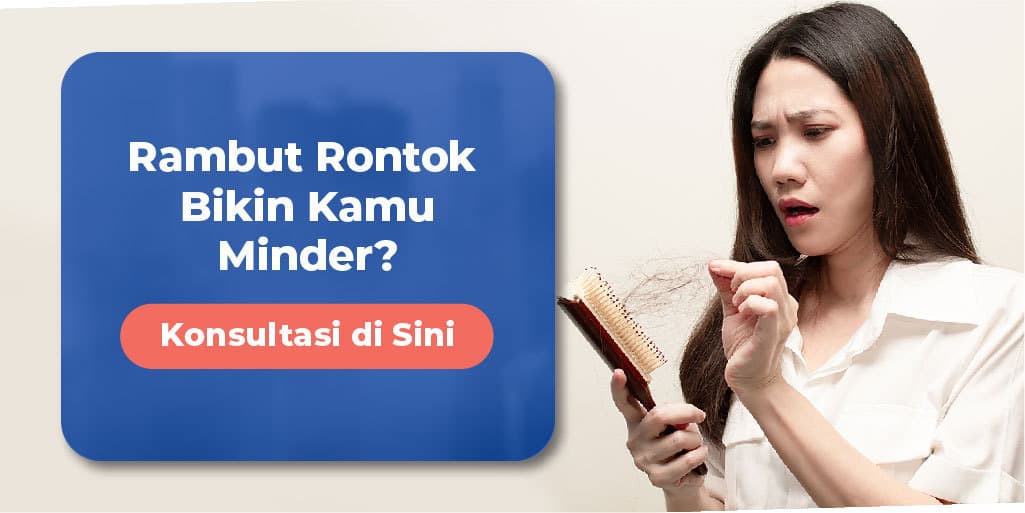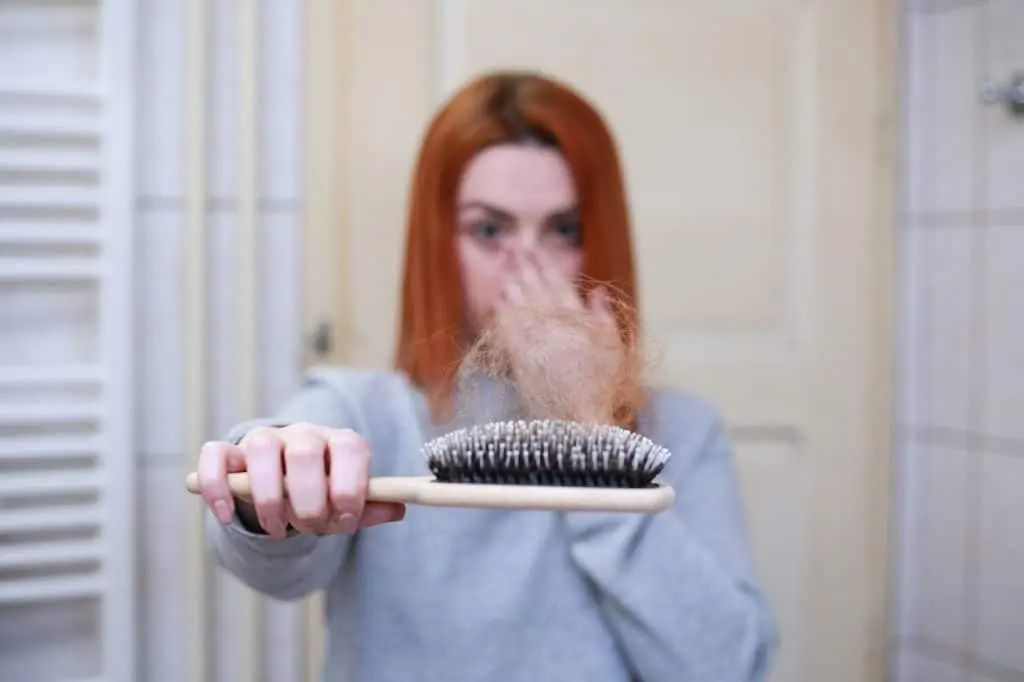Share This Article
Hair loss problems are common in both men and women. But don’t worry, because there are solutions for dealing with hair loss that you can try.

The problem of hair loss does not only occur in the scalp area. However, it is this matter of head hair that is often a concern because it can affect your appearance.
Consult about your and your family’s health problems through Good Doctor, a 24/7 service. Our doctor partners are ready to provide solutions. Come on, download the Good Doctor application here
Get to know about hair loss
Normally you will lose 50 to 100 strands of hair every day. But this number is not very significant because there are more than 100 thousand strands of hair on the head.
New hair will usually grow and replace the hair that has fallen from the roots. Unfortunately, this doesn’t happen to everyone.
Whether due to hereditary factors or hormones, quite a few people experience severe hair loss and new hair does not grow. As a result, baldness occurs, both temporary and permanent.
Symptoms of severe hair loss to pay attention to
Hair loss itself can appear in all areas of the body where hair grows. The symptoms that appear also vary.
Depends on the location of the loss and the severity. Here are some symptoms of severe hair loss that you should understand:
1. The hair on the head area begins to thin
This condition is the most common symptom, both in men and women. In men, hair loss will start from the front area and cause baldness at the hairline.
Meanwhile, in women, hair loss begins to occur in the front area and causes the forehead area to become wider.
2. Balding in certain areas
In some cases, there are also people who experience baldness only in certain areas. Not only head hair, sometimes hair loss also occurs in eyebrow hair and also beards or moustaches.
3. Sudden hair loss
Physical and emotional disorders can actually affect the strength of the hair roots. When there is stress, for example, you may experience sudden hair loss because the hair roots weaken.
Don’t be surprised if you suddenly find clumps of hair when combing or washing your hair.
4. Hair loss all over the body
This condition usually occurs because someone is undergoing certain therapy, such as chemotherapy for cancer sufferers. In many cases, hair will grow back after the therapy process is complete.
Causes of hair loss
Hair loss both on the head and other areas of the body can occur due to several conditions. Here are some of them:
1. Hereditary factors
If you have a family member with a history of baldness, the risk of experiencing hair loss and baldness is also higher.
This condition usually begins to occur with age and gets worse as you get older. In men it usually shows signs of baldness, while in women it is characterized by thinning hair.
2. Hormonal changes
Hair loss can also occur due to hormonal changes. This usually occurs in pregnant women, mothers who have just given birth, and women who are entering menopause.
After giving birth, for example, estrogen levels will decrease and indirectly have an impact on blood circulation in the head. As a result, the hair will easily separate from the follicle.
Postpartum hair loss usually occurs between four months and a year.
3. Consuming certain medications
Taking drugs for cancer, arthritis, antidepressants, heart disease drugs, and high blood pressure drugs can also cause hair loss.
4. Certain health conditions
People who suffer from thyroid disease, alopecia areata (an autoimmune disease that attacks hair cells), and people who experience hair root infections are also at high risk of experiencing hair loss.
5. Emotional stress
Physical or mental events such as high fever, stress due to death in the family, and drastic weight loss can also cause hair loss.
6. Hair care or styling
Hair loss can also occur due to improper hair care. Such as tying your hair too tightly for a long time, dyeing your hair, etc.
7. Hair loss in babies
According to the American Academy of Pediatrics, babies will lose some or all of their hair in the first few months after birth. This is very normal. Alopecia is the main factor causing baby hair loss, a condition that is influenced by the immune system.
The good news is that it is very rare for hair loss in babies to be caused by a serious medical problem. Your little one’s hair will gradually grow over time.
Apart from that, there are a number of other factors that can also cause baby hair to fall out, including:
- Telogen effluvium, which is a condition when the hair follicles are still in the ‘resting’ phase. Hair roots become weak, causing hair loss.
- Crusts on the scalp. The presence of crusts on the skin does not directly cause hair loss. Loss of hair roots can occur when parents try to clean the crust and accidentally pull out several strands.
- Fungal infection. An infection on the scalp can have an impact on the hair follicles. Infection can reduce the strength of the hair roots, causing them to fall out easily.
How to deal with hair loss
To be able to overcome hair loss, special steps need to be taken. Starting from improving nutritional intake to special therapy for hair.
1. How to deal with hair loss with a healthy diet
To maintain healthy hair condition, make sure you eat foods that are high in iron, zinc and vitamin B12.
You can get this content from foods such as nuts, fish, green vegetables and meat. Apart from that, hair follicles are also formed mostly from protein.
So don’t forget to meet your daily protein intake. If you have difficulty getting enough nutritious food, you can help by taking supplements.
2. How to treat hair loss with vitamins
Vitamins A, B, C, D, iron, selenium, and zinc are types of hair loss vitamins that play a role in hair growth.
To help maintain optimal hair growth, you can buy supplements containing these vitamins at the pharmacy.
3. How to treat hair loss with natural ingredients
You are advised to use hair loss treatment products, namely those specifically intended for hair growth. You can use several natural ingredients such as:
Coconut oil
According to a 2018 study published in the Journal of the American College of Nutrition, coconut oil can help prevent and treat some hair damage caused by treatment and exposure to ultraviolet rays from the sun.
The lauric acid content in coconut oil can help bind proteins in the hair, then protect it from damage to the roots and strands. Apart from that, massaging the head with coconut oil can also increase and improve blood flow.
Blood flow is very necessary to keep hair roots strong, prevent loss, and stimulate the growth of new hair. If you are interested in trying it, use pure coconut oil.
Olive oil
The next natural ingredient that you can use as a way to treat hair loss is olive oil. Regular use of olive oil can moisturize hair and protect it from damage such as hair loss, including that caused by genetic factors.
The method is not too difficult. Simply apply a few tablespoons of olive oil directly to your hair and scalp, massage, then leave for 30 minutes. After that, rinse with running water until clean.
Ginseng extract
So far, ginseng has been known as an herb that can treat various male virility problems. However, it turns out that ginseng can also help prevent and treat hair loss, you know.
Ginseng has certain phytochemical compounds that can increase hair growth on the scalp. At the same time, this substance will protect hair strands from potential damage, including hair loss.
4. How to deal with hair loss by washing your hair regularly
Some people believe that washing your hair regularly can cause hair loss. In fact, washing your hair regularly can actually prevent hair loss, you know.
By shampooing, your scalp will remain healthy and clean. So, it can minimize various hair damages such as hair loss.
However, still pay attention to the shampoo you use, OK? Use shampoo that has a soft texture. Shampoo with harsh chemical ingredients or compounds can also make hair dry quickly. As a result, hair breaks easily and triggers hair loss.
5. Treat your hair well
When styling your hair, it’s a good idea to avoid actions that could damage the hair roots.
Such as using a flat iron, hair dryer too often, tying your hair in a ponytail, braiding your hair tightly, and so on.
When you experience symptoms of hair loss, it’s a good idea to reduce the use of chemicals such as dyeing your hair. Because this can actually worsen the condition of your hair.
6. How to treat hair loss with laser therapy
This method is suitable for people who experience hair loss due to genetic factors or cancer chemotherapy. Low level laser exposure has been proven to restore hair thickness.
This laser therapy works by stimulating epidermal stem cells which play a role in hair growth. Currently there are many products that offer laser therapy that can be done at home.
7. How to deal with hair loss by reducing stress
Reported by GQ, Dr. Michele Green, a dermatologist from New York, said that stress can slow down the growth of new hair and cause baldness.
When we experience stress, the body releases hormones that can damage the hair growth cycle. This results in slow hair growth or even stopping growth.
8. How to treat hair loss with medical drugs
The drugs usually used to treat hair loss are Minoxidil, Finasteride, and Phenylephrine. All three are able to repair and accelerate the hair growth cycle.
Phenylephrine itself is more suitable for those of you who experience hair loss due to excessive styling.
Is it effective to use hair loss shampoo?
Overcoming hair loss is not easy, you also have to be careful in choosing shampoo. As an effort, there’s no harm in using a special hair loss shampoo.
When hair loss is severe, make sure there are these ingredients in your shampoo:
- Seaweed, soy protein and shea butter
- Biotin and pantothenic acid (vitamin B5)
- Argan oil
- Vitamin E
So, that’s a review of hair loss along with its causes and how to deal with it. If your condition doesn’t improve, don’t hesitate to see a doctor, okay?
Consult about your and your family’s health problems through Good Doctor, a 24/7 service. Our doctor partners are ready to provide solutions. Come on, download the Good Doctor application here


